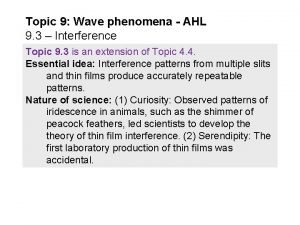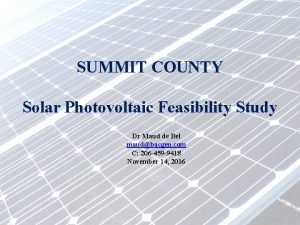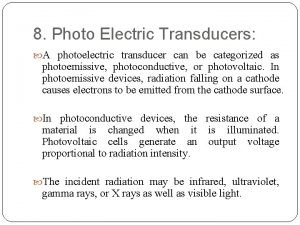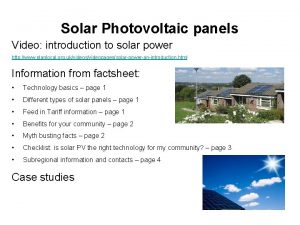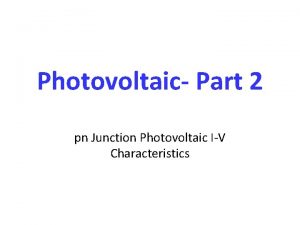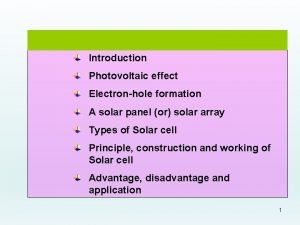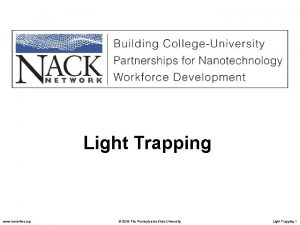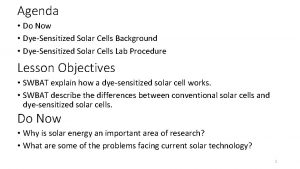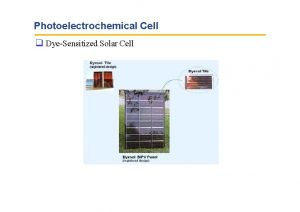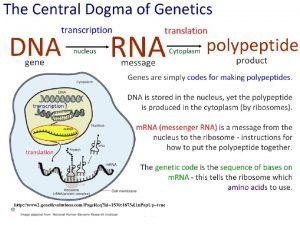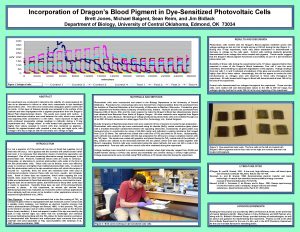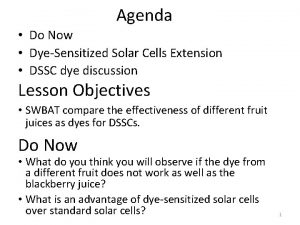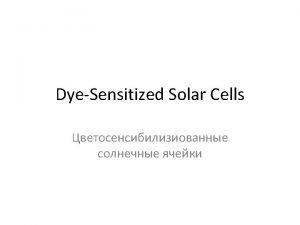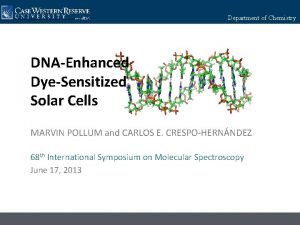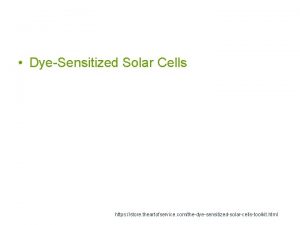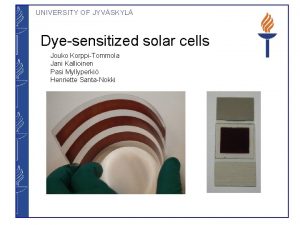C 8 Photovoltaic Cells Dyesensitized Solar Cells AHL












- Slides: 12

C 8: Photovoltaic Cells & Dyesensitized Solar Cells (AHL) By Clara Sastra

Objectives • Solar energy can be converted to Understanding: • Molecules with longer conjugated electricity in a photovoltaic cell. systems absorb light of longer • DSSCs imitate the way in which wavelength. plants harness solar energy. Electrons are “injected” from an • The electrical conductivity of a semiconductor increases with an excited molecule directly into the increase in temperature whereas Ti. O 2 semiconductor. the conductivity of metals • The use of nanoparticles coated decreases. with light absorbing dye increases • The conductivity of silicon can be the effective surface area and increased by doping to produce n- allows more light over a wider type and p-type semiconductors. range of the visible spectrum to be absorbed.

Silicon-Based Photoelectric Cells •

Silicon-Based Photoelectric Cells • Doping: A method of improving the photoelectric effect efficiency. • Involves adding small amounts of atoms of other elements: • From group 13 (Al, Ga, In) • Added extra electron can move easily through the crystal lattice > Makes it a better conductor compared to pure silicon. • its conductivity stems from negative electrons. > Produce an n-type semiconductor • From group 15 (P or As) • The element will have one less electron than silicon. > Creates a ‘hole’ in the lattice. • When free electrons move into the hole, it produces a new hole where the electron was formerly located. • Produces p-type semiconductor > the hole can be regarded as a positive carrier.

Dye-Sensitized Solar Cells (DSSCs) • In the DSSC, the photoelectrons originate from the dye when it absorbs light and then transported through a semi conductor. • Normal C=C double bond from an organic compound absorbs. • Electron is excited to higher energy level during the process. • Compound containing many alternate double and single carbon to carbon bonds are said to be conjugated • Energy required to excite an electron is lower. • More conjugated molecules = lower energy of light required. • E. g. Chlorophyll and α-carotene highly conjugated = absorb in the visible region.

Dye-Sensitized Solar Cells (DSSCs) •

Dye-Sensitized Solar Cells (DSSCs) •

Review of the Lesson Objectives Advantages of DSSCs over silicon-based photoelectric cells: • Simple to make • Semi-flexible • Semi-transparent • Cheaper • Absorbs a wider range of wavelength -> More efficient

Summary • The electrical conductivity of a semiconductor increases with increased whereas the conductivity of metals decreases. • Doping increases conductivity of silicon by producing n-type and p-type semiconductors. • Solar energy can be converted to electricity in a photovoltaic cell. • Molecules with longer conjugated systems absorb light of longer wavelength. • DSSCs imitate the way in which plants harness solar energy. Electrons are “injected” from an excited molecule directly into the Ti. O 2 semiconductor. • The use of nanoparticles coated with light absorbing dye increases the effective surface area and allows more light over a wider range of the visible spectrum to be absorbed.

Practice Problems

Practice Problems

Bibliography • Bylikin, Sergey, et al. Chemistry. Great Briain: Oxford University Press, 2014. Textbook.
 Single slit envelope
Single slit envelope Wholesale solar controller
Wholesale solar controller Solar installation summit county
Solar installation summit county Photoemissive photoconductive and photovoltaic
Photoemissive photoconductive and photovoltaic Photovoltaic video
Photovoltaic video Photovoltaic
Photovoltaic Photovoltaic effects
Photovoltaic effects Photovoltaic array maximum power point tracking array
Photovoltaic array maximum power point tracking array What is an inexhaustible source of energy
What is an inexhaustible source of energy Plasmonic solar cells
Plasmonic solar cells Cells cells they're made of organelles meme
Cells cells they're made of organelles meme Prokaryotic cells vs eukaryotic cells venn diagram
Prokaryotic cells vs eukaryotic cells venn diagram 4 types of eukaryotic cells
4 types of eukaryotic cells
